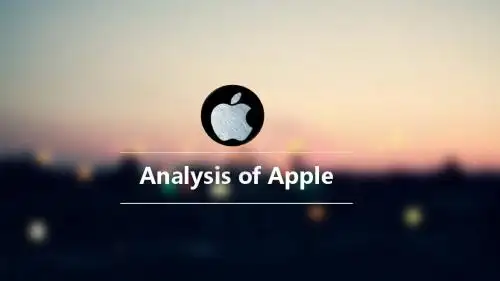英语听说课件苹果公司分析
- 格式:ppt
- 大小:708.50 KB
- 文档页数:12
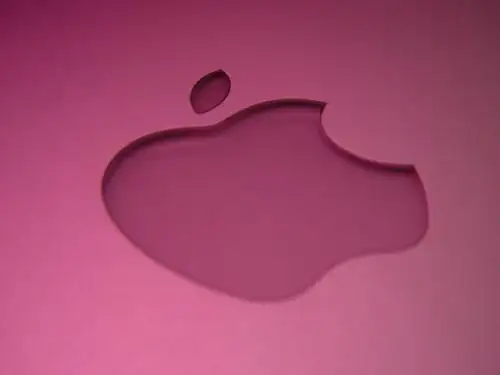
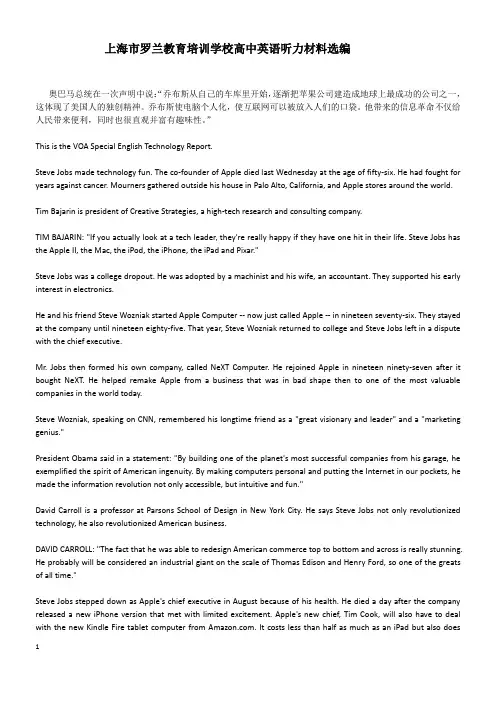
上海市罗兰教育培训学校高中英语听力材料选编奥巴马总统在一次声明中说:“乔布斯从自己的车库里开始,逐渐把苹果公司建造成地球上最成功的公司之一,这体现了美国人的独创精神。
乔布斯使电脑个人化,使互联网可以被放入人们的口袋。
他带来的信息革命不仅给人民带来便利,同时也很直观并富有趣味性。
”This is the VOA Special English Technology Report.Steve Jobs made technology fun. The co-founder of Apple died last Wednesday at the age of fifty-six. He had fought for years against cancer. Mourners gathered outside his house in Palo Alto, California, and Apple stores around the world.Tim Bajarin is president of Creative Strategies, a high-tech research and consulting company.TIM BAJARIN: "If you actually look at a tech leader, they're really happy if they have one hit in their life. Steve Jobs has the Apple II, the Mac, the iPod, the iPhone, the iPad and Pixar."Steve Jobs was a college dropout. He was adopted by a machinist and his wife, an accountant. They supported his early interest in electronics.He and his friend Steve Wozniak started Apple Computer -- now just called Apple -- in nineteen seventy-six. They stayed at the company until nineteen eighty-five. That year, Steve Wozniak returned to college and Steve Jobs left in a dispute with the chief executive.Mr. Jobs then formed his own company, called NeXT Computer. He rejoined Apple in nineteen ninety-seven after it bought NeXT. He helped remake Apple from a business that was in bad shape then to one of the most valuable companies in the world today.Steve Wozniak, speaking on CNN, remembered his longtime friend as a "great visionary and leader" and a "marketing genius."President Obama said in a statement: "By building one of the planet's most successful companies from his garage, he exemplified the spirit of American ingenuity. By making computers personal and putting the Internet in our pockets, he made the information revolution not only accessible, but intuitive and fun."David Carroll is a professor at Parsons School of Design in New York City. He says Steve Jobs not only revolutionized technology, he also revolutionized American business.DAVID CARROLL: "The fact that he was able to redesign American commerce top to bottom and across is really stunning. He probably will be considered an industrial giant on the scale of Thomas Edison and Henry Ford, so one of the greats of all time."Steve Jobs stepped down as Apple's chief executive in August because of his health. He died a day after the company released a new iPhone version that met with limited excitement. Apple's new chief, Tim Cook, will also have to deal with the new Kindle Fire tablet computer from . It costs less than half as much as an iPad but also doesless.And that's the VOA Special English Technology Report, written by June Simms and Avi Arditti. I'm Christopher Cruise. 1. mourner n.悲叹的人;哀悼者The mourner stand in silent tribute as the coffin be lay to rest灵柩下葬时,送葬者默立致哀。
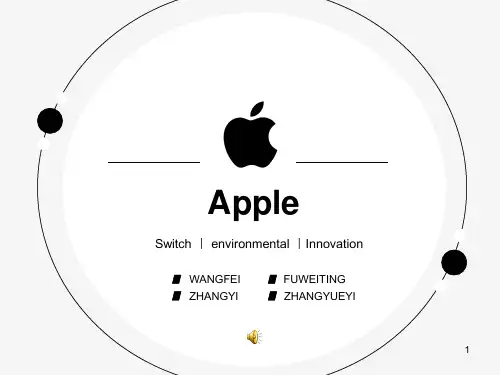
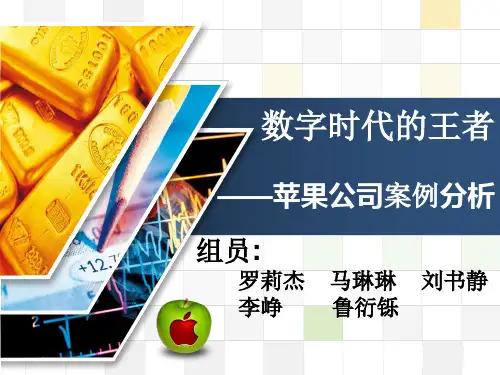
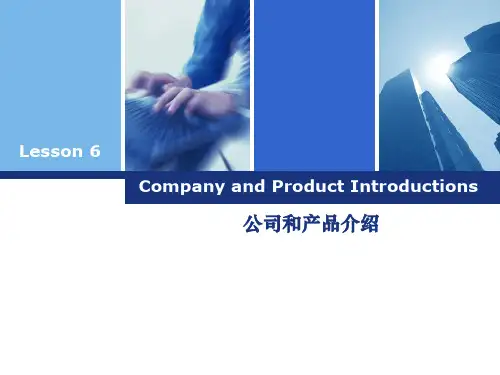
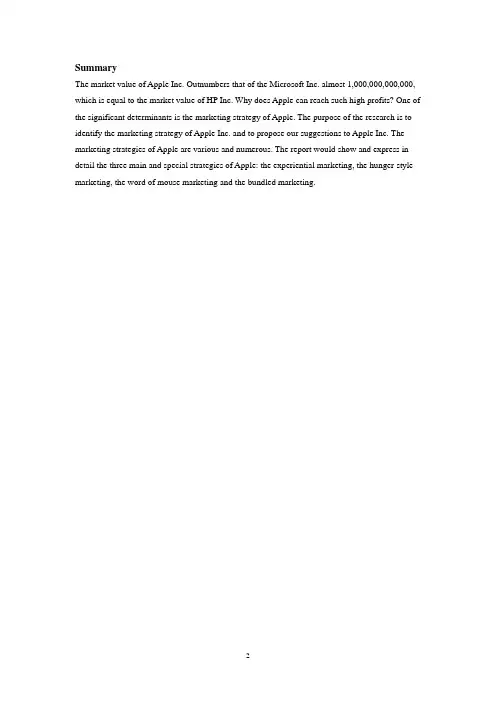
SummaryThe market value of Apple Inc. Outnumbers that of the Microsoft Inc. almost 1,000,000,000,000, which is equal to the market value of HP Inc. Why does Apple can reach such high profits? One of the significant determinants is the marketing strategy of Apple. The purpose of the research is to identify the marketing strategy of Apple Inc. and to propose our suggestions to Apple Inc. The marketing strategies of Apple are various and numerous. The report would show and express in detail the three main and special strategies of Apple: the experiential marketing, the hunger-style marketing, the word of mouse marketing and the bundled marketing.Contents1. Company introduction (1)2. Experiential marketing (2)2.1 Location (1)2.2 Area (1)2.3 Product (1)2.4 Design (1)3. Hunger-style marketing (1)3.1 Exclusive (1)3.2 Mystery (1)3.3 Fanfare (1)3.4 Entertainment (1)3.5 Play tricks (1)4. Bundled marketing (1)4.1 The iTunes Store: I’m the pied piper (1)4.2 App store (1)5. Conclusions (1)1. Company introduction2. Experiential marketingThe most companies are based on "customer first", however, “unless we could find the ways to get our message to customers at the store, we were screwed.” Jobs said.Jobs hated to cede control of anything, especially when it might affect the customer experience. But he faced a problem. There was one part of the process he didn't control: the experience of buying an Apple product in a store.The days of the Byte Shop were over. Industry sales were shifting from local computer specialty shops to mega-chais and big box stores, where most clerks had neither the knowledge nor the incentive to explain the distinctive nature of Apple products. "All that the salesman cared about was a $50 spiff", Jobs said. Other computers were pretty generic, but Apple's had innovative features and a higher price tag. He didn't want an iMac to sit on a shelf between a Dell and a Compaq while an uninformed clerk recited the specs of each. "Unless we could find ways to get our message to customers at the store, we were screwed."Then there are some elements of Apple retail stores.2.1 Location: Apple stores should be in malls and on Main Streets--in areas with a lot of foot traffic, no matter how expensive. "We may not be able to get them to drive ten miles to check out our products, but we can get them to walk ten feet," he said.2.2 Area:The size of a store signaled the importance of the brand. A good company must "impute"--it must convey its values and importance in everything it does, from packaging to marketing. The store will become the most powerful physical expression of the brand," he predicted. The store must be big enough, Otherwise you won't be relevant.2.3 Product: There weren't many, not enough to fill the shelves of a conventional store, but that was an advantage. The type of store they would build, they decided, would benefit from having few products. It would be minimalist and airy and offer a lot of places for people to try our things. People think of Apple as a cult. You want to move from a cult to something cool, and having an awesome store where people can try things with help that. The stores would impute the ethos of Apple products: playful, easy, creative, and on the bright side of the line between hip and intimidating.2.4 Design: Jobs particularly focused on the staircases. When he visited a store as it was being constructed, he invariably suggested changes to the staircase. His name is listed as the lead inventor on two patent applications on the staircases.In July 2011, a decade after the first ones opened, there were 326 Apple stores. The biggest was in London's Covent Garden, the tallest in Tokyo's Ginza. The average annual revenue per storewas $34 million, and the total net sales in fiscal 2010 were $9.8 billion.3. Hunger-style marketingApple’s products is so popular and the result comes from the con trolling on market, that is, making the market be in “Hunger-style”. It is good at keeping stability of the prices on products. The sale on iphone is the representative of this strategy apparently, when it is on the market. No matter how the voice of this product is Apple has always adhered to the limited supply. However, why people expect Apple’s products so crazy and so hunger? I think that it is mostly derived from marketing techniques: fanfare before marketing it.If the more unknown things are about to come, people will be more urgent to know the truth. “Curiosity killed the cat” that is the nature of such a person, and Apple took advantage of the people of this crowd human nature the mind.Apple fans look forward to the launch of Apple’s cell phone more than a year. However it was not until the date that almost everyone guessed it called the iPhone, but almost no one guessed its appearance and its various properties of marvel.In fact, many customers do not want to be catered better but not to satisfy to stimulate their interest.Apple’s marketing strategy is contrary to the marketing concept of "customer first". Instead, he actively use the hunger of the five basic principles of marketing and harvest was a great success.3.1 Exclusive: modern marketing proposition: as long as the customer needs, we have enough supply. Hunger-style marketing deliberately controls the supply and let the customer.3.2 Mystery: When Apple launching a new product, it will select the mysterious theater-act play in the form of publicity, sparking a strong people's curiosity.3.3 Fanfare: the world is full of commercial publicity and the goal of fanfare goal is to ensure that there is a wide talk on the product. Before Apple iPhone become a legend.3.4 Entertainment: the marketing must be attractive to participate. Movie srars release kinds of information on the microblogging and there is a sign that the information comes from iphone.3.5Play tricks: trick is not necessarily to be subtle, and a very poor approach may have been enough. For example, Apple will mark its products and the meaning of the times, but in the end you will find that what you buy is only one phone.4. Bundled marketing4.1 The iTunes Store: I’m the pied piperApple's iTunes Music Store an online music store, which established in order to sell the iPod. It integrates iPod hardware and software and online services to sell in bundling. Through the ITunes digital music management software, customers can listen to music in the iPod player and search, browse, download, and category management.This model achieved win-win patterns among the record companies, music stores andconsumers. However, there are some problems behind this unique business model may affect Apple.First of all, the company's music products related to intellectual property rights of third parties. Franchise agreement’s expiration date is usually shorter, and some products and services may unwittingly infringement.Secondly, in the online music market, the bargaining power of the music providers usually relatively strong, added with the short-term concessive agreement between the Apple and third-party content provider (CP), then Apple’s reduce will be reduced.Finally, since Apple’s music sales system is a closed (exclusive) music sales system, from the long-term perspective, if there is problem on the hardware design and production or online music sales, it will affect the company's overall development.In summary, to Apple, this bundling business model with first-mover advantage in the digital entertainment market, and generates good returns, but from the opposite side, some hidden dangers exist, what the sales of the company's ability to maintain, we can only wait and see.4.2 App storeApp store is based on its own self-marketing platform for the center. It helps develop and promote the application to the client, and it also helps users find products and services they need, it includes a search engine, ranking, advertising and other promotional tools.App Store biased in favor of inducing people. Apple lowers the threshold cost, efficient software testing services and other means to attract developers. According to statistics, the Apple App Store has about13,700developers, and nearly300new applications are provided daily. A large number of applications have also attracted numerous users to download. The fees charged and shared by Apple and developers.5. ConclusionsWhy Apple is so fascinating? Why the fans of Apple Inc. are so crazy and the media eager to report when Apple Inc. public one product? Where does the charm of the top products express? I believe these are the elements: taste, grace and fashion, that is, the characteristic of the brand.The market value of Apple Inc. Outnumbers that of the Microsoft Inc. almost 1,000,000,000,000, which is equal to the market value of HP Inc. Its success largely depends on the knowledge of human nature and customer demands.Based on such analysis, we can conclude that the marketing strategies play an important and indispensable role in composing the great profits of Apple.Firstly, the experiential marketing well expresses the mission of Apple -- consumer first -- and provides a perfect circumstance of purchase. Now, in July 2011, a decade after the first ones opened, there were 326 Apple stores. The biggest was in London's Covent Garden, the tallest inTokyo's Ginza. The average annual revenue per store was $34 million, and the total net sales in fiscal 2010 were $9.8 billion.Secondly, In fact, many customers do not want to be catered better but not to satisfy to stimulate their interest. Apple’s products is so popular and the result comes from the controlling on market, that is, making the market be in “Hunger-style”. It is good at keeping stability of the prices on products.Last, to Apple, this bundling business model with first-mover advantage in the digital entertainment market, and generates good returns, but from the opposite side, some hidden dangers exist, what the sales of the company's ability to maintain, we can only wait and see.。
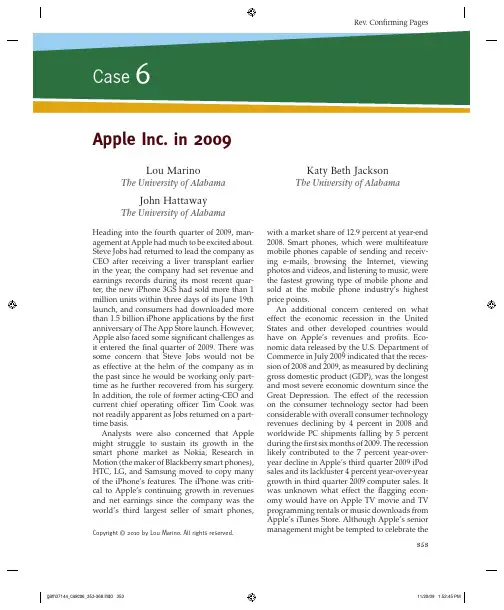
Rev. Confirming Pages353with a market share of 12.9 percent at year-end2008. Smart phones, which were multifeature mobile phones capable of sending and receiv-ing e-mails, browsing the Internet, viewing photos and videos, and listening to music, were the fastest growing type of mobile phone and sold at the mobile phone industry’s highest price points. A n additional concern centered on what effect the economic recession in the United States and other developed countries would have on Apple’s revenues and profits. Eco-nomic data released by the U.S. Department of Commerce in July 2009 indicated that the reces-sion of 2008 and 2009, as measured by declining gross domestic product (GDP), was the longest and most severe economic downturn since the Great Depression. The effect of the recession on the consumer technology sector had been considerable with overall consumer technology revenues declining by 4 percent in 2008 and worldwide PC shipments falling by 5 percent during the first six months of 2009. The recession likely contributed to the 7 percent year-over-year decline in Apple’s third quarter 2009 iPod sales and its lackluster 4 percent year-over-year growth in third quarter 2009 computer sales. It was unknown what effect the flagging econ-omy would have on Apple TV movie and TV programming rentals or music downloads from Apple’s iTunes Store. Although Apple’s senior management might be tempted to c elebrate theA pple Inc. in 2009L ou M arinoT he University of AlabamaJ ohn H attawayT he University of AlabamaK aty Beth J acksonT he University of AlabamaH eading into the fourth quarter of 2009, man-agement at Apple had much to be excited about. Steve Jobs had returned to lead the company as CEO after receiving a liver transplant earlier in the year, the company had set revenue and earnings records during its most recent quar-ter, the new iPhone 3GS had sold more than 1 million units within three days of its June 19th launch, and consumers had downloaded more than 1.5 billion iPhone applications by the first anniversary of The App Store launch. However, Apple also faced some significant challenges as it entered the final quarter of 2009. There was some concern that Steve J obs would not be as effective at the helm of the company as in the past since he would be working only part-time as he further recovered from his surgery. In addition, the role of former acting-CEO and current chief operating officer Tim Cook was not readily apparent as Jobs returned on a part-time basis. A nalysts were also concerned that Apple might struggle to sustain its growth in the smart phone market as Nokia, Research in Motion (the maker of Blackberry smart phones), HTC, LG, and Samsung moved to copy many of the iPhone’s features. The iPhone was criti-cal to Apple’s continuing growth in revenues and net earnings since the company was the world’s third largest seller of smart phones,6Copyright © 2010 by Lou Marino. All rights reserved.Confirming Pages 354 Part Two: Section A: Crafting Strategy in Single-Business Companiescompany’s recent successes, the convergence of such serious challenges facing the company called for an evaluation of its strategic situation and its approach to sustaining advantage in the consumer technology sector.H istory of Apple Inc.S teven Wozniak and Steven Jobs founded Apple Computer in 1976 when they began selling a crudely designed personal computer called the Apple I to Silicon Valley computer enthusiasts. Two years later the partners introduced the first mass-produced personal computer, the Apple II. The Apple II boasted the first color display and eventually sold more than 10,000 units. While the Apple II was relatively successful, the next revision of the product line, the Macintosh (Mac), would dramatically change personal computing through its user-friendly graphical user interface (GUI) that allowed users to inter-act with screen images rather than merely type text commands.T he Macintosh that was introduced in 1984 was hailed as a breakthrough in personal com-puting, but did not have the speed, power, or software availability to compete with the PC that IBM had introduced in 1981. One of the rea-sons the Macintosh lacked the necessary soft-ware was that Apple put very strict restrictions on the Apple Certified Developer Program, which made it difficult for software developers to obtain Macs at a discount and receive infor-mational materials about the operating system.W ith the Mac faring poorly in the market, founder Steve J obs became highly critical of the company’s president and CEO, John Scul-ley, who had been hired by the board in 1983. Finally, in 1985, as Sculley was preparing to visit China, Jobs devised a “boardroom coup” to replace him. Sculley found out about the plan and canceled his trip. After Apple’s board voted unanimously to keep Sculley in his posi-tion, Jobs, who was retained as chairman of the company but stripped of all decision-making authority, soon resigned. During the remainder of 1985, Apple continued to encounter prob-lems and laid off one-fifth of its e mployees while posting its first ever quarterly loss. In addition, Sculley entered into a legal battle with Microsoft’s Bill Gates over the introduction of Windows 1.0, which used similar technology to the Mac’s GUI. Gates eventually signed a document that in effect ensured that Microsoft would not use Mac technology in Windows 1.0 but claimed no such promises for any later ver-sions of Windows. Essentially, Apple had lost the exclusive right to use its own GUI.D espite these setbacks, Apple kept bringing innovative products to the market, while closely guarding the secrets behind its technology. In 1987, Apple released a revamped Macintosh computer that proved to be a considerable suc-cess. This computer was easy to use, making it a favorite at schools and in homes. In addition, the second Macintosh had excellent graph-ics capabilities. However, by 1990, PCs with Microsoft software had flooded the market and Windows technology was far more prevalent than Mac technology because Microsoft had licensed its software for use on computers built by many different companies.I n 1991, Apple released its first-generation notebook computer, the PowerBook, and, in 1993, Apple’s board of directors opted to remove Sculley from the position of CEO. The board chose to place the chief operating officer, Michael Spindler, in the vacated spot. Although Spindler was not a personable, accessible leader, he did oversee Apple’s development of several impor-tant products. First, in 1994, Apple released the PowerMac family of PCs, the first Macs to incor-porate the PowerPC chip, a very fast processor co-developed with Motorola and IBM. Spindler also made a somewhat half-hearted attempt to license the Macintosh operating system (Mac OS) to other companies. However, very few companies ever chose to license the Mac OS because many felt the licensing agreements were far too restrictive.B y 1995, Apple had bigger problems, includ-ing $1 billion in back orders and insufficient parts to build those machines. And worse, in the late summer of 1995, Microsoft released Windows 95, which was well suited to competewith the strengths of the Mac OS. During theConfirming PagesCase6Apple Inc. in 2009 355winter of 1995–96, Apple made some misguided judgments concerning its product line and as a result posted a loss for that quarter. In January 1996, Apple asked Spindler to resign and chose Gil Amelio, former president of National Semi-conductor, to take his place.D uring his first 100 days in office, Amelio announced many sweeping changes for the company. He split Apple into seven distinct divisions, each responsible for its own profit or loss, and he tried to better inform the devel-opers and consumers of Apple’s products and projects. Although Apple announced a stagger-ing first-quarter loss of $740 million in 1996, the company brought down its losses to $33 mil-lion by quarter two, an achievement that finan-cial experts had not imagined Apple could accomplish. And in the third quarter, Apple again beat the best estimates, reporting a $30 million profit. At the end of 1996, the company astonished the industry when it announced that it planned to acquire NeXT, the company Steve J obs had founded upon his resignation from Apple in 1985; Jobs was to be rehired by Apple as part of the acquisition. The acquisi-tion was chosen in order to control NeXTstep, the basis Apple planned to use for its next-generation operating system, Rhapsody. During the summer of 1997, after announc-ing another multimillion-dollar quarterly loss, Apple d etermined that Gil Amelio had made many significant improvements in Apple’s operations but had done all he could. No per-manent replacement was announced, but Fred Anderson, chief financial officer, was placed in charge of daily operations; Jobs was also given an expanded role in the company.J obs’s “expanded role” soon became more clear in terms of his responsibilities—Apple had no CEO, stock prices were at a five-year low, and important decisions needed to be made. Jobs was referred to as “interim CEO,” and 1997 proved to be a landmark year for his company. MacWorld Boston was held in August, and J obs was the keynote speaker. He used that event to make several signifi-cant announcements that would turn Apple around: There would be an almost entirely new board of directors, an aggressive advertis-ing campaign, and an alliance with Microsoft. Microsoft received $150 million in Apple stock, Apple would have a five-year patent cross-license, and the old legal battle between the two companies would finally be resolved. As part of the resolution to the legal dispute, Microsoft paid an undisclosed amount to Apple to quiet the allegations that it had stolen Apple’s intel-lectual property (the Mac GUI) and agreed to make Windows 98 available to Mac users by year’s end. Jobs also effectively ended Apple’s licensing agreements with other companies, buying out all but one, with the understanding that that company would serve only the low-end market for computers (under $1,000). At a late 1997 press conference, Jobs announced that Apple would begin selling direct to consumers over the Web and by phone. Within a week, the Apple store was the third largest e-commerce site on the Web.J obs continued to make several changes dur-ing 1998, a year in which Apple reported a profit in all four quarters. Apple’s stock price was on the rise, and the company had released the iMac, an all-new design for the Macintosh that was meant to serve the lower-end consumer market. The computer had more than enough process-ing capabilities than most consumers would ever need and was priced affordably. In the fall of that year, the iMac was the best-selling com-puter in the United States. Apple followed up that s uccess by introducing the iBook in 1999, the portable counterpart to the iMac, a laptop meant to be stylish, affordable, and powerful. Through-out 1999, Apple’s stock continued to soar; in the fall it reached a high in the upper $70s.I n early 2000, J obs announced that he was now permanent CEO of Apple. The remainder of that year was a slow one for Apple and for the rest of the computer industry. As a result, Apple reported its first quarterly loss in three years. In late 2000, the company cut prices across the board; then, in early 2001, it released a new set of PowerMacs with optical drives that let consumers both listen to and burn CDs as well as both read and write to DVDs. In May 2001, Jobs announced that Apple would openConfirming Pages356 Part Two: Section A: Crafting Strategy in Single-Business Companiesensuring that all operations of Apple ran effi-ciently and smoothly. Together they worked to ensure that Apple could continue to be a vital, innovative company in a very competitive envi-ronment. Cook took on the role of acting CEO after Steve Jobs took a leave of absence to deter-mine the cause of his declining health, which became apparent to outsiders in fall 2008.A pple’s Situation in 2009U nder Cook’s leadership, Apple’s sales of com-puters, iPods, iPhones, and iTunes downloads allowed it to set annual revenue and earnings records in 2008—records that it appeared would be broken in 2009. The company reported its best-ever quarterly results in the third quar-ter of fiscal 2009 with revenues of $8.34 billion compared to $7.46 billion for the same quarter the previous year and a net quarterly profit of $1.23 billion, up from $1.07 billion during the same period in 2008. Apple shipped a record 2.6 million Macintosh units (up 4 percent from the same quarter the previous year) and 10.2 mil-lion iPods (a 7 percent decline from the same quarter the previous year), and 5.2 million iPhones (a 626 percent increase from the third quarter of 2008). A summary of Apple’s finan-cial performance for fiscal years 2005–2008 is provided in E xhibit 1 .A pple managed its businesses largely on a geographic basis. Its primary geographic seg-ments included the Americas (North America and South America); Europe, Africa, and the Middle East; and J apan. It also had a Retail division that operated the Apple-owned stores in the United States, Italy, Japan, Canada, and the United Kingdom. The company’s pri-mary product lines were Macintosh products (including desktops and portables); iPods, iPhones; iTunes (including other music-related products and services); peripherals (including other hardware); and software, service, and other sales. The company’s net sales by oper-ating segment and product line and unit sales by product line for 2004 through 2008 are pro-vided in E xhibit 2 . several retail stores that would sell Apple prod-ucts as well as third-party products, including MP3 players, digital cameras, and digital video cameras.I n October 2001, Apple released the iPod—a product that revolutionized the company and the digital music player industry. In 2003, when the company released iTunes, the online retail store where consumers could purchase indi-vidual songs legally, the success of the venture skyrocketed. The technology was available only for Macs at first but had since become available for PC users as well. By July 2004, 100 million songs had been sold and iTunes had a 70 per-cent market share among all legal online music download services. Apple’s success continued to grow, largely thanks to the iPod and iTunes.B y 2005, Jobs’s leadership had placed Apple at the forefront of the digital music player industry and had established the company as a player once again in the computer industry. From the moment J obs returned to Apple, he had idea after idea for how to improve the com-pany and turn its performance around. He not only consistently pushed for innovative new ideas and products but also enforced several structural changes, including ridding the com-pany of unprofitable segments and divisions. He managed to blend his leadership style, which epitomized the spirit and standards on which Apple was founded, with the business discipline the younger J obs had lacked. J obs also credited Apple’s success to its skilled man-agement team, including Tim Cook.T imothy D. Cook was Apple’s executive vice president of worldwide sales and opera-tions. Cook reported to the CEO and managed Apple’s supply chain, sales activities, and ser-vice and support in all markets and countries. His position was accountable for maintaining Apple’s flexibility in serving more demand-ing consumers. Cook had worked first for IBM and then for Compaq, gaining extensive expe-rience in technological industries. While J obs provided the vision for the organization, Cook and the other members of the executive staffand the board of directors were responsible forConfirming PagesCase 6 Apple Inc. in 2009 357sellers who collectively controlled 81.4 percent of the market—see E xhibit 3 . Internationally, the top five computer manufacturers controlled 60.1 percent of the market, with Apple account-ing for only 2 percent of international computer shipments. Prior to the onset of the recession that had impacted most developed countries, the PC industry had been expected to grow at aP ersonal Computer Industry I n the second quarter of 2009, the worldwide PC market declined by 5 percent when compared to the second quarter of 2008. In the U.S. market, total shipments declined by a more modest 1.2 percent. The PC industry was relatively consol-idated, with the U.S. market dominated by fiveE xhibit 1 2008200720062005Net sales:Domestic $18,469$14,128$11,486$8,334International 14,010 9,878 7,829 5,597Total net sales32,47924,00619,31513,931Costs and expenses:Cost of sales21,33415,85213,7179,889Research and development (R&D)1,109782712535Selling, general and administrative (SG&A) 3,761 2,963 2,433 1,864Total operating expenses 4,8703,7453,1452,399Operating income6,2754,4092,4531,643Other income and expense620599365165Income before provision for income taxes 6,8955,0082,8181,808Provision for income taxes 2,0611,512829 480Net income$ 4,834$ 3,496$ 1,989$1,328Earnings per common share—Diluted $ 5.36$ 3.93$ 2.27$ 1.55Shares used in computing earnings per share—Diluted (in thousands)902,139889,292877,526856,878Financial position as of September of yearCash, cash equivalents, and short-term investments $24,490$15,386$10,110$8,261Accounts receivable, net 2,4221,6371,252895Inventories509346270165Property, plant, and equipment, net 2,4551,8321,281817Total assets39,57225,34717,20511,516Current liabilities 14,0929,2996,4433,487Noncurrent liabilities 4,4501,516778601Shareholders’ equity$21,030$14,532$9,984$7,428Regular employees32,01021,55017,78714,806Temporary employees and contractors3,0662,1162,3992,020International net sales as a percentage of total net sales 43%41%41%40%Gross margin as a percentage of net sales 34.3%34.0%29.0%29.0%R&D as a percentage of net sales3%3%4%4%Source: From Apple Investor Relations, h ttp:///media_files/irol/10/107357/AAPL_3YR_Q407.pdf (accessed July 13, 2008); h ttp:///media_files/irol/10/107357/AAPL_3YR_Q407.pdf (accessed July 13, 2008); and h ttp:///library/10/107/107357/items/314467/AAPL_3YR_Q4FY08.pdf(accessed July 30, 2009).Rev. Confirming Pages358 Part Two: Section A: Crafting Strategy in Single-Business Companiesp rimarily the iPod and iPhone, the companystill saw computers as its core business. Apple’s proprietary operating system and strong graph-ics handling capabilities differentiated Macs from PCs, but many consumers and business users who owned PCs were hesitant to purchasea Mac because of Apple’s premium pricing andbecause of the learning curve involved with mastering its proprietary operating system.rate of 5–6 percent to reach $354 billion by 2012.However, the continuation of the U.S. recession beyond economists’ projections caused most industry analysts to avoid making firm fore-casts of future demand.A pple’s Computer Operations E ven though Apple’s revenues were increas-ingly coming from noncomputer products, aOther segments include Asia Pacific and FileMaker. bIncludes iMac, eMac, Mac mini, Power Mac, and Xserve product lines. cIncludes MacBook, MacBook Pro, iBook. and PowerBook product lines. dConsists of iTunes Music Store sales, iPod services, and Apple-branded and third-party iPod accessories. eDerived from handset sales, carrier agreements, and Apple-branded and third-party iPhone accessories. fIncludes sales of Apple-branded and third-party displays, wireless connectivity and networking solutions, and other hardware accessories. gIncludes sales of Apple-branded operating system, application software, third-party software, AppleCare, and Internet services. hDerived by dividing total Macintosh net sales by total Macintosh unit sales. iDerived by dividing total iPod net sales by total iPod unit sales.S ource: Apple Inc., 10-K report filed with the SEC on November 15, 2007.E xhibit 2 20082007200620052004NET SALES BY OPERATING SEGMENTAmericas net sales $14,573$11,596$ 9,415$ 6,950$4,019Europe net sales 7,6225,4604,0963,0731,799Japan net sales 1,5091,0821,211920677Retail net sales6,3154,1153,2462,3501,185Other segments net sales a 2,4601,7531,347998599Total net sales$32,479$24,006$19,315$13,931$8,279NET SALES BY PRODUCTDesktops b$ 5,603$ 4,020$ 3,319$ 3,436$2,373Portables c8,673 6,294 4,056 2,839 2,550Total Macintosh net sales $14,27610,3147,3756,2754,923iPod9,1538,3057,3754,5401,306Other music-related products and services d3,3402,4961,885899278iPhone and related products and services e1,844123———Peripherals and other hardware f 1,6591,2601,1001,126951Software, service, and other sales g 2,2071,5081,2791,091821Total net sales$32,479$24,006$19,315$13,931$8,279UNIT SALES BY PRODUCTDesktops b 3,7122,7142,4342,5201,625Portables c6,003 4,337 2,869 2,014 1,665Total Macintosh unit sales9,7157,0515,3034,5343,290Net sales per Macintosh unit sold h $ 1,469$ 1,463$ 1,391$ 1,384$1,496iPod unit sales54,82851,63039,40922,4974,416Net sales per iPod unit sold i $ 167$ 161$ 195$ 202$ 296iPhone unit sales11,6271,389———Confirming PagesCase 6 Apple Inc. in 2009 359weighed only three pounds. The MacBook Air had won critical acclaim for both its design and its ease of use, and was one of the prod-ucts helping Apple gain ground in the competi-tive computer industry. All Apple computers were priced at a steep premium compared to PCs and laptops offered by Dell, HP , and other rivals. The company lowered the prices of all computer models by 10 percent or more in June 2009, with the price of the MacBook Pro falling to $1,199 and the MacBook Air getting a $300 price cut to $1,499.C ompetitors in the PC MarketD ELL Dell, the industry leader in PC sales,recorded net revenues of $61.1 billion for the fi scal year 2009—see E xhibit 4 . Dell’s 2009 revenues included the effect of a fourth quar-ter year-over-year sales decline of 48 percent that refl ected the effect of the U.S. recession on the PC industry. Of this revenue, about 29Many analysts still projected that Apple’s great-est opportunity for growth would come from the projected halo effect of iPods and iPhones and that some consumers (but probably not business users) might switch to Apple comput-ers after purchasing an iPod or iPhone.A pple’s computer product line consisted of several models in various configurations. Its desktop lines included the Mac Pro (aimed at professional and business users); the iMac (tar-geted toward consumer, educational, and busi-ness use); and Mac mini (made specifically for consumer use). Apple had three notebook prod-uct lines as well: MacBook Pro (for professional and advanced consumer users), the MacBook (designed for education users and consumers), and the MacBook Air (designed for profes-sional and consumer users). In both the desk-top and notebook lines, the “Power” products were higher-end and offered more computing power at a premium price. The other models were lower on the price scale but still priced high relative to Wintel sellers.T he MacBook Air was Apple’s most recent notebook introduction. The MacBook Air was designed to target users who valued both por-tability and power. The notebook featured a 13.3-inch screen, a full-size keyboard, a built-in video camera, and cutting-edge wireless con-nectivity. This sleek notebook was only 0.76 inches at its maximum height when closed andS ource: w , October 2008; and “Gartner SaysWorldwide PC Shipments Declined 5 Percent in Second Quar-ter of 2009,” B usiness Wire, July 15, 2009.E xhibit 3 COMPANYQ2 2007Q2 2008Q2 2009Dell Inc.27.9%31.6%26.0%Hewlett-Packard 25.825.125.7Acer 10.68.014.2Apple 6.48.48.7Toshiba 5.6 5.5 6.8Others 23.721.318.6S ource: Dell Inc. 2008 and 2009 10-Ks.E xhibit 4 DPRODUCT CATEGORYFISCAL YEAR ENDEDJANUARY 30, 2009FEBRUARY 1, 2008FEBRUARY 2, 2007Mobilityproducts (notebooks etc.)31%28%27%Desktop PCs 293234Software and peripherals 171616Servers and networking hardware101110Professionalconsulting and support services 999Storage products 444 Totals 100%100%100%Rev. Confirming Pages360 Part Two: Section A: Crafting Strategy in Single-Business Companiesthe fi rst mass-produced computer for export from Taiwan; in 1985, it founded Taiwan’s fi rst and largest franchised retail computer chain. The company was renamed Acer in 1987, and a decade later it purchased the mobile PC divi-sion of Texas Instruments. By 2008, Acer had become the world’s third largest computer manufacturer. Acer’s 2008 consolidated reve-nues rose by approximately 18 percent from the previous year, to reach $16.6 billion, while oper-ating income increased by 38 percent, to reach $428.8 million. In addition, its 55 percent annual growth in global shipments during 2008 made it the industry’s fastest growing PC manufac-turer. Acer’s largest geographic segment was Europe/Middle East/Africa, which accounted for 54.3 percent of the company’s PC, desktop, and notebook sales. Acer had become the fast-est growing PC sellers in the United States, largely as a result of its multi-brand strategy that positioned Acer, Gateway, eMachines, and Packard Bell at distinct price points in the market for PCs. The company based its com-petitive strategy on its four pillars of success: a winning business model, competitive prod-ucts, an innovative marketing strategy, and an effi cient operation model. The company’s com-puter offering included desktop and mobile PCs, LCD monitors, servers and storage, and high-defi nition TVs and projectors. Heading into 2009, the company expected to be able to continue to increase revenues through its focus on low-priced notebook computers sold by U.S. discount consumer electronics retailers. percent came from sales of desktop PCs. These PCs ranged from low-end bargain desktops to high-end gaming setups with the latest hard-ware and software. However, competition in the desktop market was lowering the profi t-ability of desktop sales. Dell, a company that attempted to be a low-cost provider through supply chain and distribution logistics, was beginning to see a shift in consumer demand toward mobility products (laptops, notebook computers, handheld computers, and tablet PCs). Dell’s notebook computers, like its desk-tops, ranged from low-end, low-priced models to state-of-the-art, high-priced models. This segment showed promising revenue growth for Dell. The company also offered peripherals such as printers, monitors, projectors, and WiFi products as it attempted to move into a role as a consumer electronics provider along with its role as a PC manufacturer. H EWLETT-PACKARD Hewlett-Packard’s Personal Systems Group (PSG) accounted for about 35.7 percent of the company’s 2008 reve-nues of $118 billion. Imaging and various services accounted for the second largest percentage of the company’s revenues, at 24.8 percent. From 2007 to 2008, the PSG experienced revenue growth of 16.2 percent and a 22 percent increase in unit vol-ume. The company’s sales of desktop PCs grew by just 5 percent during 2008, while laptop rev-enues increased by 28 percent between 2007 and 2008. HP’s strongest growth was in emerging markets. However, the company’s sales fell by 13 percent during the fi rst quarter of 2009 as busi-nesses and consumers purchased fewer comput-ers. E xhibit 5 provides the revenue contribution by PSG product line for 2005 through 2008. Like Dell, HP offered desktops and notebooks in vari-ous confi gurations, with prices determined by the features offered and hardware contained in the systems. HP also offered peripherals such as televisions and related media devices, and was well-known in the imaging and printer markets. A CER Acer, a multinational manufacturer based in Taiwan, was founded in 1976 as Multi-tech, with 11 employees. In 1979, Acer designedS ource: Hewlett-Packard 2007 and 2008 10-Ks.E xhibit 5 HPRODUCT2008200720062005Notebooks $22,657$17,650$12,005$ 9,763Desktop PCs 16,62615,88914,64114,406Workstations 1,9021,7211,3681,195Handhelds 360531650836Other 750618502541Total $42,295$36,409$29,166$26,741。

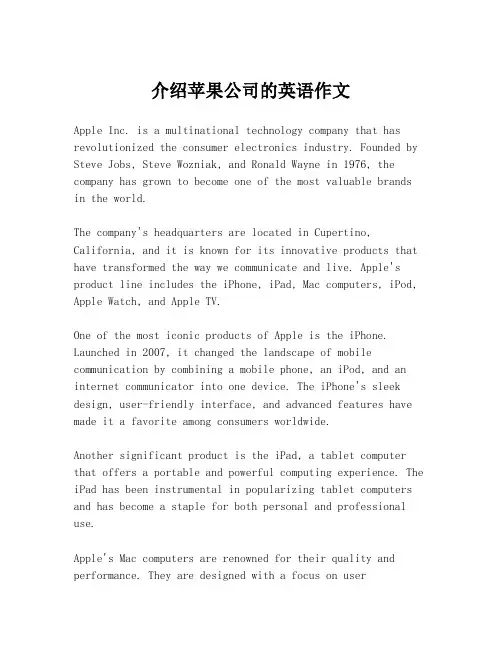
介绍苹果公司的英语作文Apple Inc. is a multinational technology company that has revolutionized the consumer electronics industry. Founded by Steve Jobs, Steve Wozniak, and Ronald Wayne in 1976, the company has grown to become one of the most valuable brands in the world.The company's headquarters are located in Cupertino, California, and it is known for its innovative products that have transformed the way we communicate and live. Apple's product line includes the iPhone, iPad, Mac computers, iPod, Apple Watch, and Apple TV.One of the most iconic products of Apple is the iPhone. Launched in 2007, it changed the landscape of mobile communication by combining a mobile phone, an iPod, and an internet communicator into one device. The iPhone's sleek design, user-friendly interface, and advanced features have made it a favorite among consumers worldwide.Another significant product is the iPad, a tablet computer that offers a portable and powerful computing experience. The iPad has been instrumental in popularizing tablet computers and has become a staple for both personal and professional use.Apple's Mac computers are renowned for their quality and performance. They are designed with a focus on userexperience, offering a seamless integration with other Apple devices and services.The company has also made significant strides in the music industry with the iPod and the iTunes Store. The iPod revolutionized the way we listen to music, and iTunes became the largest music retailer in the United States.In addition to hardware, Apple has also developed a robust ecosystem of software and services, including the App Store, which offers millions of apps for iOS devices, and iCloud, which provides cloud storage and services.Apple is committed to innovation and has a strong focus on design and user experience. The company's dedication to creating products that are both aesthetically pleasing and highly functional has garnered it a loyal customer base and a reputation for excellence.In conclusion, Apple Inc. is a leading technology companythat has had a profound impact on the way we live and work. Its innovative products and services have set the standardfor the industry and continue to inspire and delight consumers around the world.。
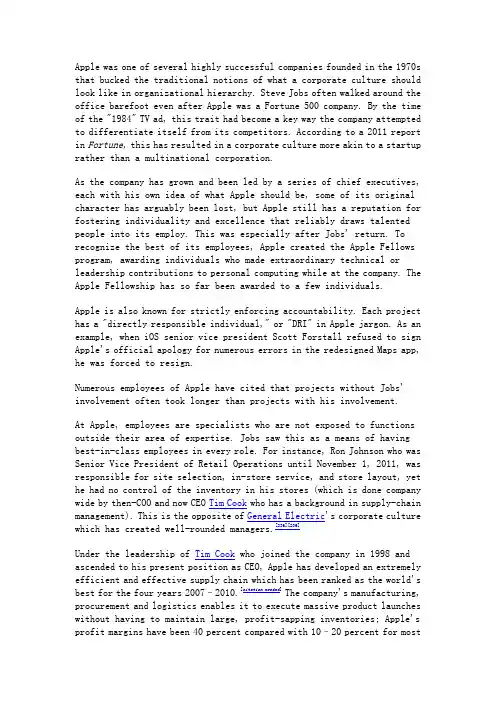
Apple was one of several highly successful companies founded in the 1970s that bucked the traditional notions of what a corporate culture should look like in organizational hierarchy. Steve Jobs often walked around the office barefoot even after Apple was a Fortune 500 company. By the time of the "1984" TV ad, this trait had become a key way the company attempted to differentiate itself from its competitors. According to a 2011 report in Fortune,this has resulted in a corporate culture more akin to a startup rather than a multinational corporation.As the company has grown and been led by a series of chief executives, each with his own idea of what Apple should be, some of its original character has arguably been lost, but Apple still has a reputation for fostering individuality and excellence that reliably draws talented people into its employ. This was especially after Jobs' return. To recognize the best of its employees, Apple created the Apple Fellows program, awarding individuals who made extraordinary technical or leadership contributions to personal computing while at the company. The Apple Fellowship has so far been awarded to a few individuals.Apple is also known for strictly enforcing accountability. Each project has a "directly responsible individual," or "DRI" in Apple jargon. As an example, when iOS senior vice president Scott Forstall refused to sign Apple's official apology for numerous errors in the redesigned Maps app, he was forced to resign.Numerous employees of Apple have cited that projects without Jobs' involvement often took longer than projects with his involvement.At Apple, employees are specialists who are not exposed to functions outside their area of expertise. Jobs saw this as a means of having best-in-class employees in every role. For instance, Ron Johnson who was Senior Vice President of Retail Operations until November 1, 2011, was responsible for site selection, in-store service, and store layout, yet he had no control of the inventory in his stores (which is done company wide by then-COO and now CEO Tim Cook who has a background in supply-chain management). This is the opposite of General Electric's corporate culture which has created well-rounded managers.[236][236]Under the leadership of Tim Cook who joined the company in 1998 and ascended to his present position as CEO, Apple has developed an extremely efficient and effective supply chain which has been ranked as the world's best for the four years 2007–2010.[citation needed]The company's manufacturing, procurement and logistics enables it to execute massive product launches without having to maintain large, profit-sapping inventories; Apple's profit margins have been 40 percent compared with 10–20 percent for mostother hardware companies in 2011. Cook's catchphrase to describe his focus on the company's operational edge is “Nobody wants to buy sour milk”. The company previously advertised its products as being made in America up to the late 1990s, however as a result of outsourcing initiatives in the 2000s almost all of its manufacturing is now done abroad. According to a report by the New York Times, Apple insiders "believe the vast scale of overseas factories as well as the flexibility, diligence and industrial skills of foreign workers have so outpaced their American counterparts that “Made in the U.S.A.” is no longer a viable option for most Apple products".Unlike other major US companies, Apple has a relatively simple compensation policy for executives, which does not include perks that other CEOs enjoy such as country club fees and private use of company aircraft. The company usually grants stock options to executives every other year.。
